Bulbs
Flower Basics
Flower Beds & Specialty Gardens
Flower Garden
Garden Furniture
Garden Gnomes
Garden Seeds
Garden Sheds
Garden Statues
Garden Tools & Supplies
Gardening Basics
Green & Organic
Groundcovers & Vines
Growing Annuals
Growing Basil
Growing Beans
Growing Berries
Growing Blueberries
Growing Cactus
Growing Corn
Growing Cotton
Growing Edibles
Growing Flowers
Growing Garlic
Growing Grapes
Growing Grass
Growing Herbs
Growing Jasmine
Growing Mint
Growing Mushrooms
Orchids
Growing Peanuts
Growing Perennials
Growing Plants
Growing Rosemary
Growing Roses
Growing Strawberries
Growing Sunflowers
Growing Thyme
Growing Tomatoes
Growing Tulips
Growing Vegetables
Herb Basics
Herb Garden
Indoor Growing
Landscaping Basics
Landscaping Patios
Landscaping Plants
Landscaping Shrubs
Landscaping Trees
Landscaping Walks & Pathways
Lawn Basics
Lawn Maintenance
Lawn Mowers
Lawn Ornaments
Lawn Planting
Lawn Tools
Outdoor Growing
Overall Landscape Planning
Pests, Weeds & Problems
Plant Basics
Rock Garden
Rose Garden
Shrubs
Soil
Specialty Gardens
Trees
Vegetable Garden
Yard Maintenance
Care for a Cleveland Pear Tree
Care for a Cleveland Pear Tree. Cleveland pear trees are ornamental, non-fruit-bearing trees that produce beautiful white flowers each spring. They are not as easily damaged by wind and ice conditions as other types of ornamental pear trees and produce more flowers than other pear trees. This makes them the more economical choice in the long run...

Cleveland pear trees are ornamental, non-fruit-bearing trees that produce beautiful white flowers each spring. They are not as easily damaged by wind and ice conditions as other types of ornamental pear trees and produce more flowers than other pear trees. This makes them the more economical choice in the long run for your garden as well as a very pretty addition. Cleveland pears do best in zones 4 through 9, and taking care of them is not difficult.
Things You'll Need
Water hose
Tree trimmer
Plant in a location where the Cleveland pear will receive at least several hours of direct sunlight each day. Make sure you plant it with lots of room to grow. A Cleveland pear can get 15 or so feet wide and 30 to 35 feet tall. Cleveland pears are not that picky about the soil in which they are planted. Rich, sandy or clay are all fine; however, they do best in a well-draining dirt. The main requirement of the soil is that the pH level be 6.0 to 7.0.
Trim limbs if they are getting near wires or too wide. This is not a necessary step if the branches are not going to hinder anything or obstruct a view. Pear trees naturally shape in a nice oval with a point similar to the shape of a pear. If you are going to cut a few limbs, cut at a joint using a tree trimmer; if they are small limbs, use loppers.
Water the tree by placing a hose near the bottom of the tree and turn the nozzle on so that water is trickling out. Adjust the hose position every five to 10 minutes so the entire root system gets water. Keep watering for 30 minutes. Do this to supplement rainfall.
Cut off limbs that have died or are severely damaged as well as those with disease. This will keep the tree from trying to send nutrients to an area that doesn't need it or cannot be healed. Cleveland pear trees are resistant to fire blight, but this doesn't mean they cannot get it on occasion. You will notice the problem when flowers and leaves turn black and die. Trim out infected branches at least a foot below the infection.
Apply fungicide to Entomosporium leaf spot. This is a disease that causes purple and reddish spots on leaves that will result in the leaves dying. The fungicide will help with the disease if you catch it early enough. Cutting out infected areas will also help as well as raking up leaves to prevent the spread.